2003 VOLVO XC70 heating
[x] Cancel search: heatingPage 59 of 257
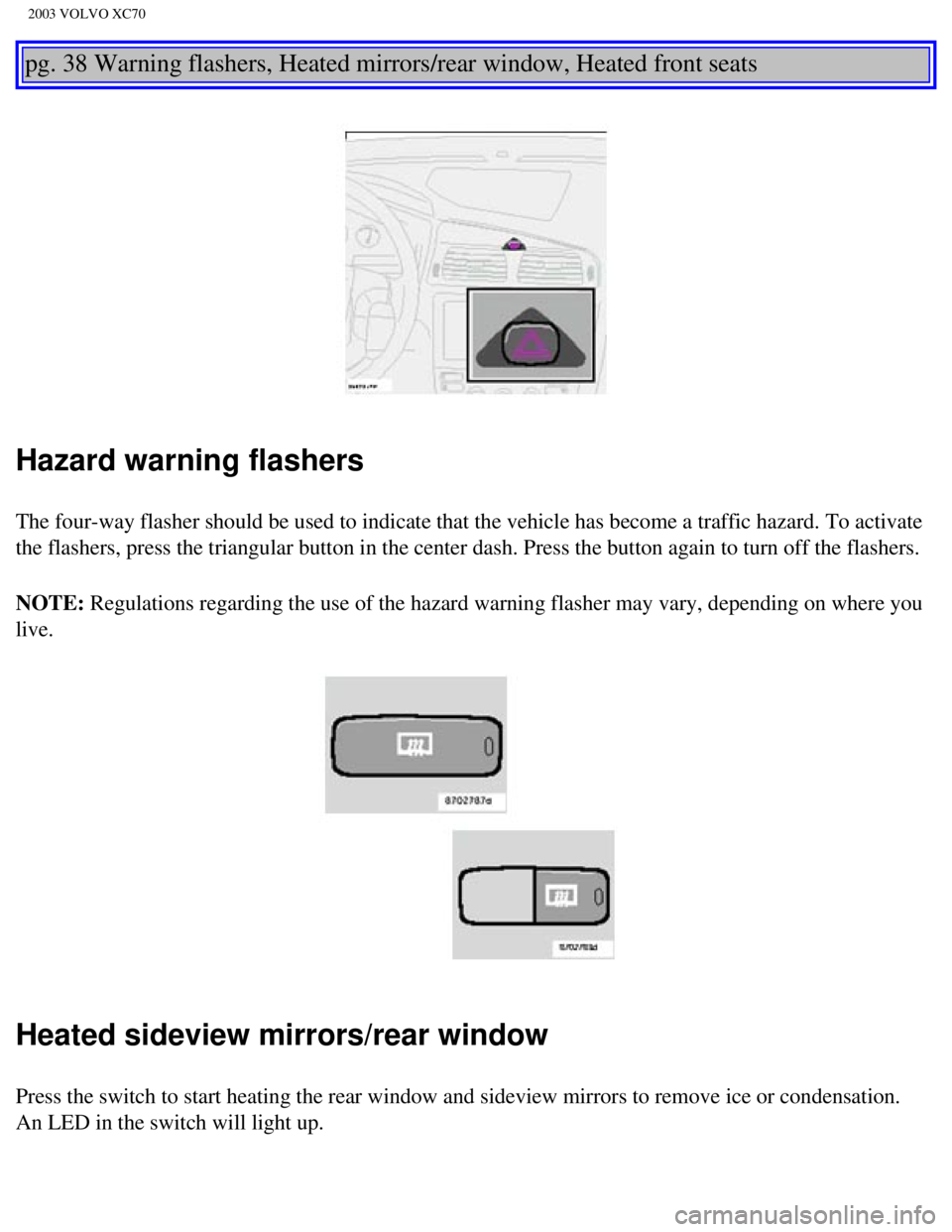
2003 VOLVO XC70
pg. 38 Warning flashers, Heated mirrors/rear window, Heated front seats
Hazard warning flashers
The four-way flasher should be used to indicate that the vehicle has bec\
ome a traffic hazard. To activate
the flashers, press the triangular button in the center dash. Press the \
button again to turn off the flashers.
NOTE: Regulations regarding the use of the hazard warning flasher may vary, de\
pending on where you
live.
Heated sideview mirrors/rear window
Press the switch to start heating the rear window and sideview mirrors t\
o remove ice or condensation.
An LED in the switch will light up.
file:///K|/ownersdocs/2003/2003_XC70/03xc70_02b.htm (9 of 18)12/30/200\
6 4:17:54 PM
Page 60 of 257
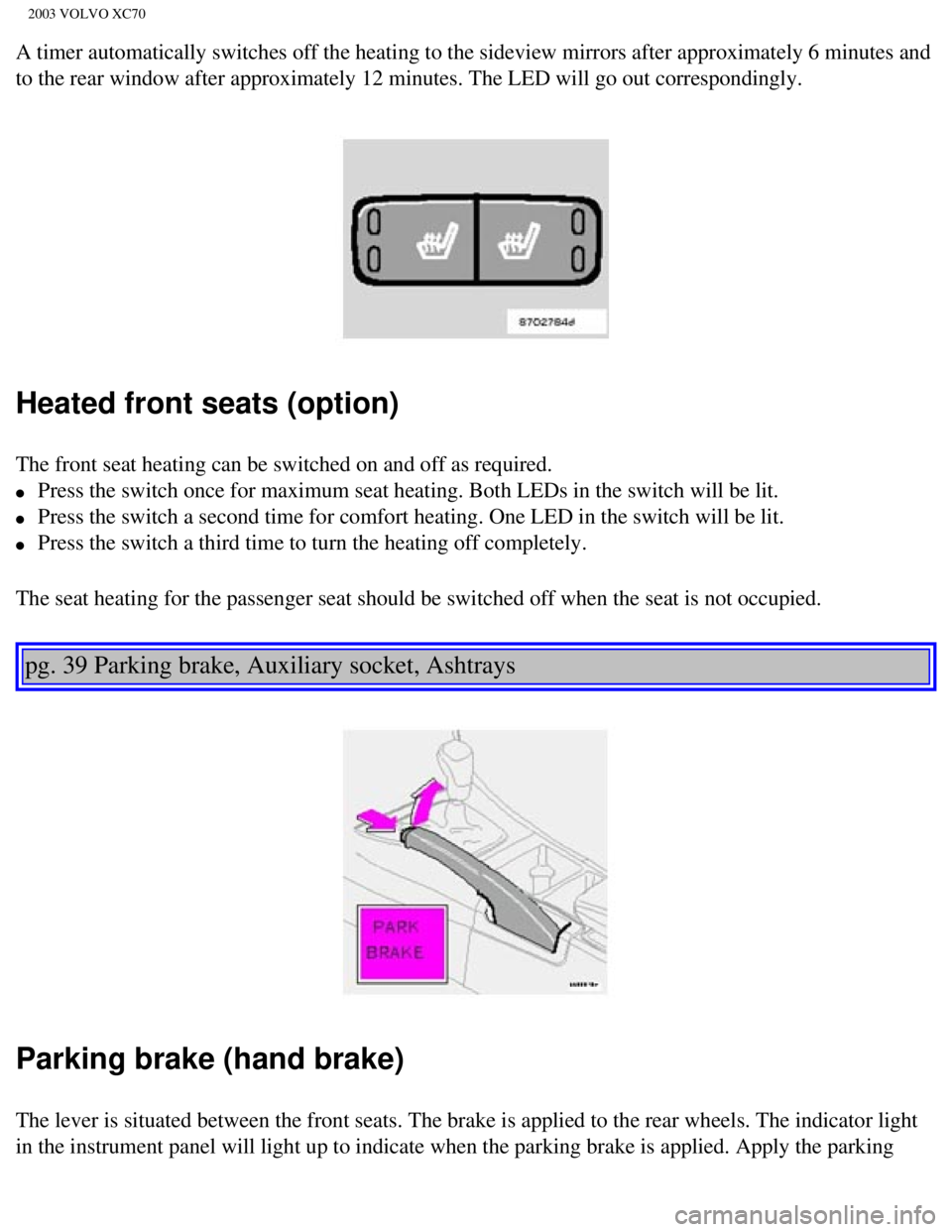
2003 VOLVO XC70
A timer automatically switches off the heating to the sideview mirrors a\
fter approximately 6 minutes and
to the rear window after approximately 12 minutes. The LED will go out c\
orrespondingly.
Heated front seats (option)
The front seat heating can be switched on and off as required.
l Press the switch once for maximum seat heating. Both LEDs in the switch \
will be lit.
l Press the switch a second time for comfort heating. One LED in the switc\
h will be lit.
l Press the switch a third time to turn the heating off completely.
The seat heating for the passenger seat should be switched off when the \
seat is not occupied.
pg. 39 Parking brake, Auxiliary socket, Ashtrays
Parking brake (hand brake)
The lever is situated between the front seats. The brake is applied to t\
he rear wheels. The indicator light
in the instrument panel will light up to indicate when the parking brake\
is applied. Apply the parking
file:///K|/ownersdocs/2003/2003_XC70/03xc70_02b.htm (10 of 18)12/30/20\
06 4:17:54 PM
Page 71 of 257

2003 VOLVO XC70
A Open
B Closed
C Horizontal air flow
D Vertical air flow
Direct the air vents toward the rear side windows to demist.
Direct the air vents toward the rear seat for the best heating/cooling e\
ffect.
pg. 47 Climate control system - general information
Condensation on the inside of the windows
Keeping the insides of the windows clean will help reduce the amount of \
condensation that forms on the
windows. Use a commercial window cleaning agent to clean the windows.
Ice and snow
Always keep the air intake grille at the base of the windshield free of \
snow.
Cabin air filter
Replace the cabin air filter with a new one at the recommended intervals\
. The filter should be replaced
more often when driving under dirty and dusty conditions. The filter can\
not be cleaned and therefore
should always be replaced with a new one.
Sensors
The sunlight sensor on the dashboard and passenger compartment temperatu\
re sensor in the ECC control
panel should not be covered in any way as this could cause incorrect inf\
ormation to be sent to the ECC
system.
Parking the car in warm weather
If your car has been parked in the sun in warm weather, opening the wind\
ows and sun roof (option) for
file:///K|/ownersdocs/2003/2003_XC70/03xc70_03.htm (3 of 12)12/30/2006\
4:17:55 PM
Page 73 of 257
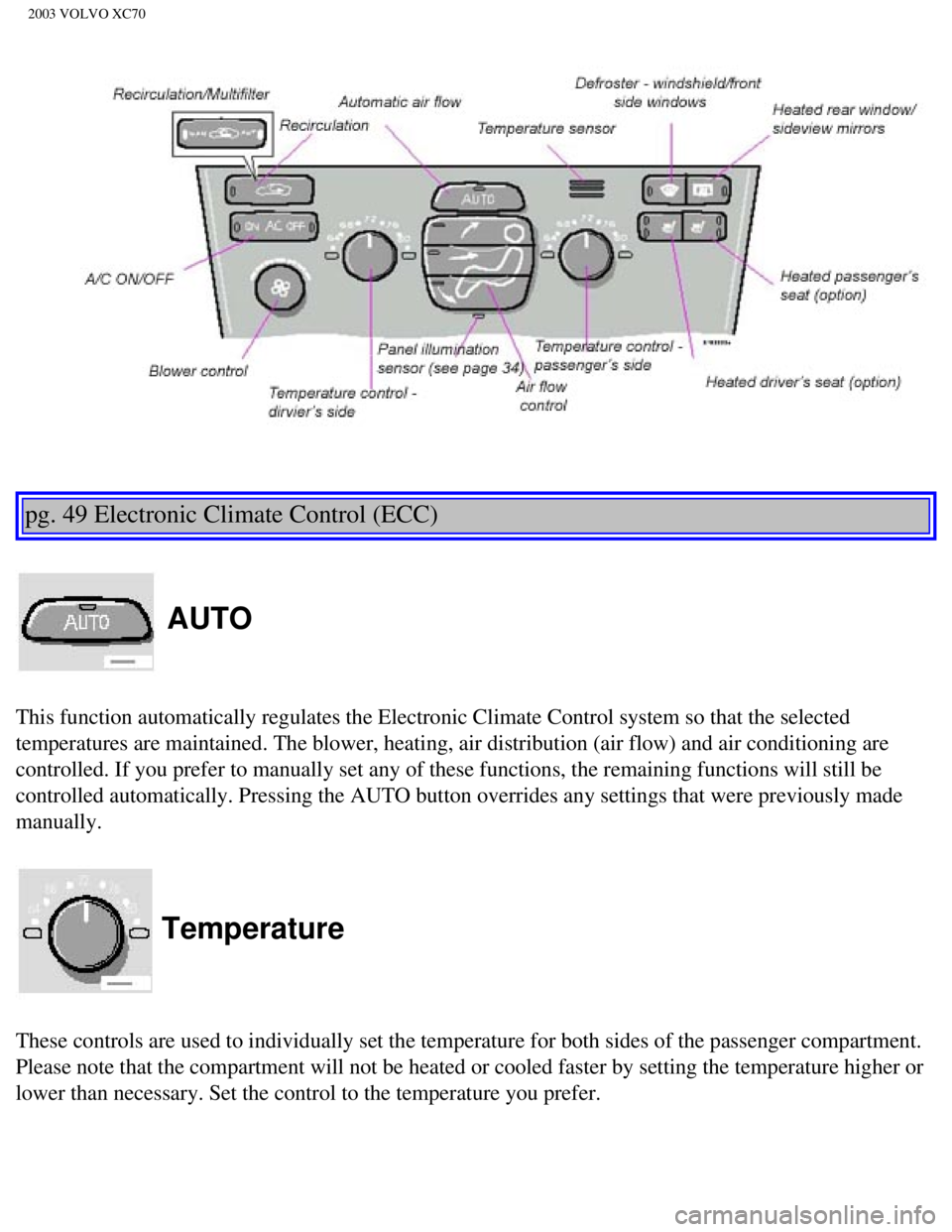
2003 VOLVO XC70
pg. 49 Electronic Climate Control (ECC)
AUTO
This function automatically regulates the Electronic Climate Control sys\
tem so that the selected
temperatures are maintained. The blower, heating, air distribution (air\
flow) and air conditioning are
controlled. If you prefer to manually set any of these functions, the re\
maining functions will still be
controlled automatically. Pressing the AUTO button overrides any setting\
s that were previously made
manually.
Temperature
These controls are used to individually set the temperature for both sid\
es of the passenger compartment.
Please note that the compartment will not be heated or cooled faster by \
setting the temperature higher or
lower than necessary. Set the control to the temperature you prefer.
file:///K|/ownersdocs/2003/2003_XC70/03xc70_03.htm (5 of 12)12/30/2006\
4:17:55 PM
Page 74 of 257
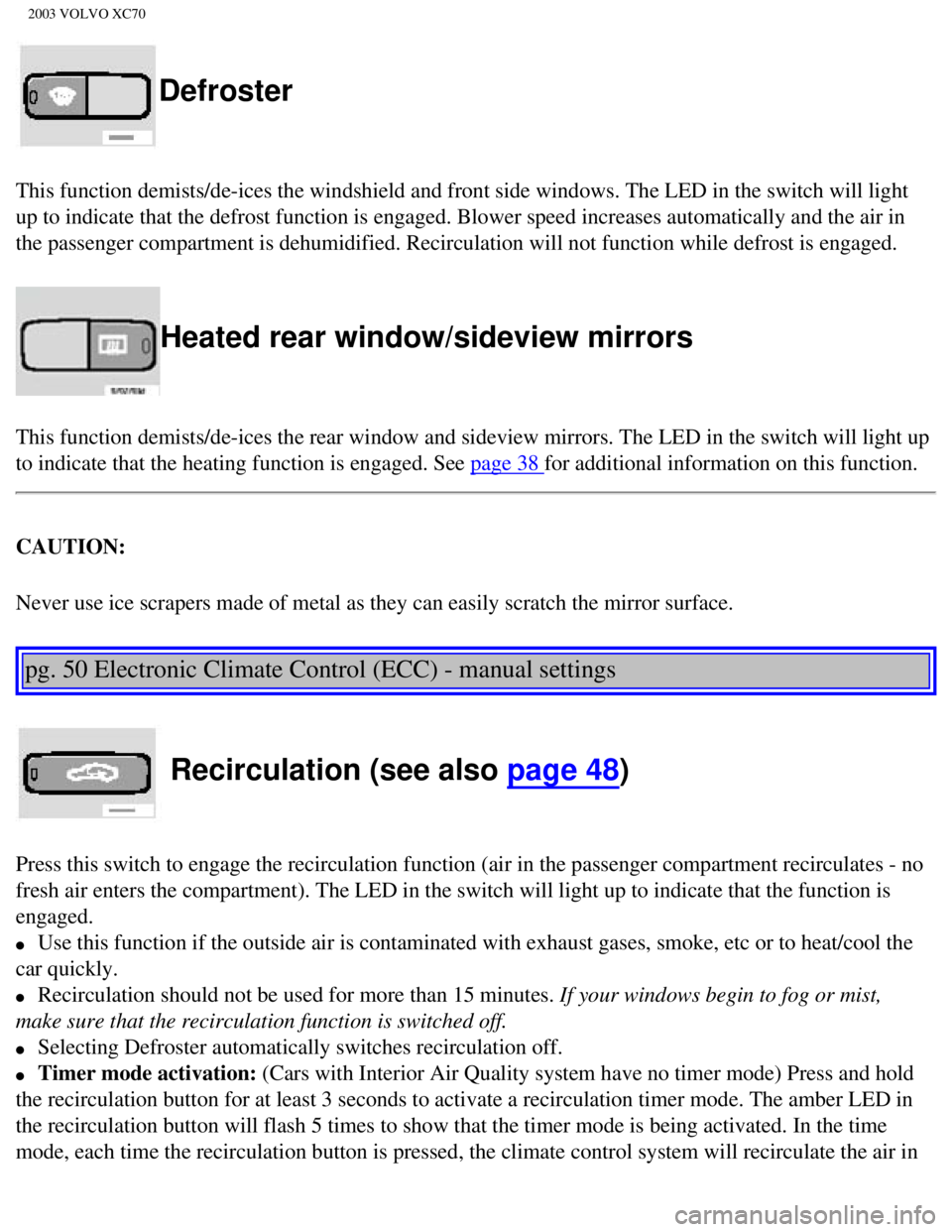
2003 VOLVO XC70
Defroster
This function demists/de-ices the windshield and front side windows. The\
LED in the switch will light
up to indicate that the defrost function is engaged. Blower speed increa\
ses automatically and the air in
the passenger compartment is dehumidified. Recirculation will not functi\
on while defrost is engaged.
Heated rear window/sideview mirrors
This function demists/de-ices the rear window and sideview mirrors. The \
LED in the switch will light up
to indicate that the heating function is engaged. See
page 38 for additional information on this function.
CAUTION:
Never use ice scrapers made of metal as they can easily scratch the mirr\
or surface.
pg. 50 Electronic Climate Control (ECC) - manual settings
Recirculation (see also page 48)
Press this switch to engage the recirculation function (air in the pass\
enger compartment recirculates - no
fresh air enters the compartment). The LED in the switch will light up \
to indicate that the function is
engaged.
l Use this function if the outside air is contaminated with exhaust gases,\
smoke, etc or to heat/cool the
car quickly.
l Recirculation should not be used for more than 15 minutes. If your windows begin to fog or mist,
make sure that the recirculation function is switched off.
l Selecting Defroster automatically switches recirculation off.
l Timer mode activation: (Cars with Interior Air Quality system have no timer mode) Press and \
hold
the recirculation button for at least 3 seconds to activate a recirculat\
ion timer mode. The amber LED in
the recirculation button will flash 5 times to show that the timer mode \
is being activated. In the time
mode, each time the recirculation button is pressed, the climate control\
system will recirculate the air in
file:///K|/ownersdocs/2003/2003_XC70/03xc70_03.htm (6 of 12)12/30/2006\
4:17:55 PM
Page 78 of 257
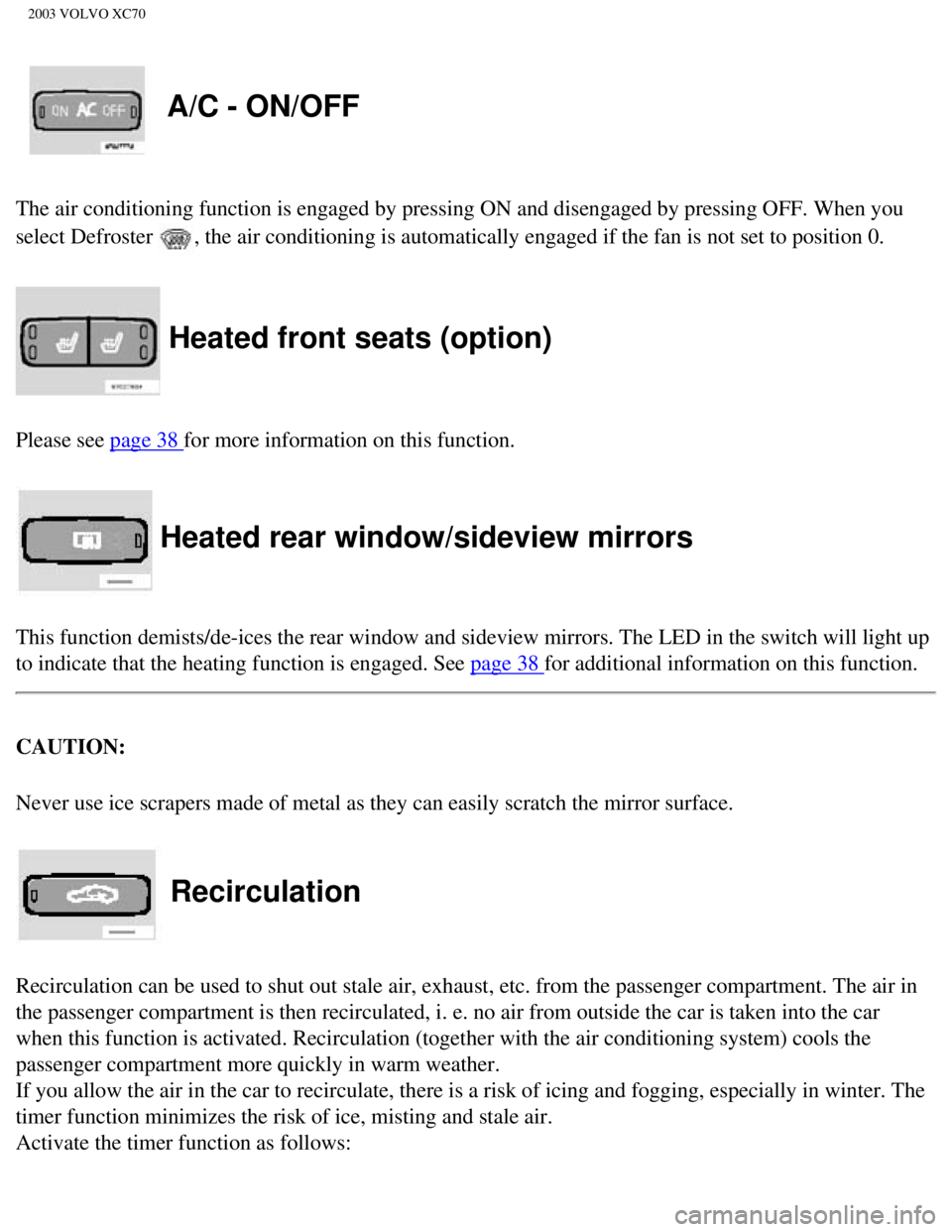
2003 VOLVO XC70
A/C - ON/OFF
The air conditioning function is engaged by pressing ON and disengaged b\
y pressing OFF. When you
select Defroster
, the air conditioning is automatically engaged if the fan is not set to\
position 0.
Heated front seats (option)
Please see page 38 for more information on this function.
Heated rear window/sideview mirrors
This function demists/de-ices the rear window and sideview mirrors. The \
LED in the switch will light up
to indicate that the heating function is engaged. See
page 38 for additional information on this function.
CAUTION:
Never use ice scrapers made of metal as they can easily scratch the mirr\
or surface.
Recirculation
Recirculation can be used to shut out stale air, exhaust, etc. from the \
passenger compartment. The air in
the passenger compartment is then recirculated, i. e. no air from outsid\
e the car is taken into the car
when this function is activated. Recirculation (together with the air c\
onditioning system) cools the
passenger compartment more quickly in warm weather.
If you allow the air in the car to recirculate, there is a risk of icing\
and fogging, especially in winter. The
timer function minimizes the risk of ice, misting and stale air.
Activate the timer function as follows:
file:///K|/ownersdocs/2003/2003_XC70/03xc70_03.htm (10 of 12)12/30/200\
6 4:17:55 PM
Page 129 of 257
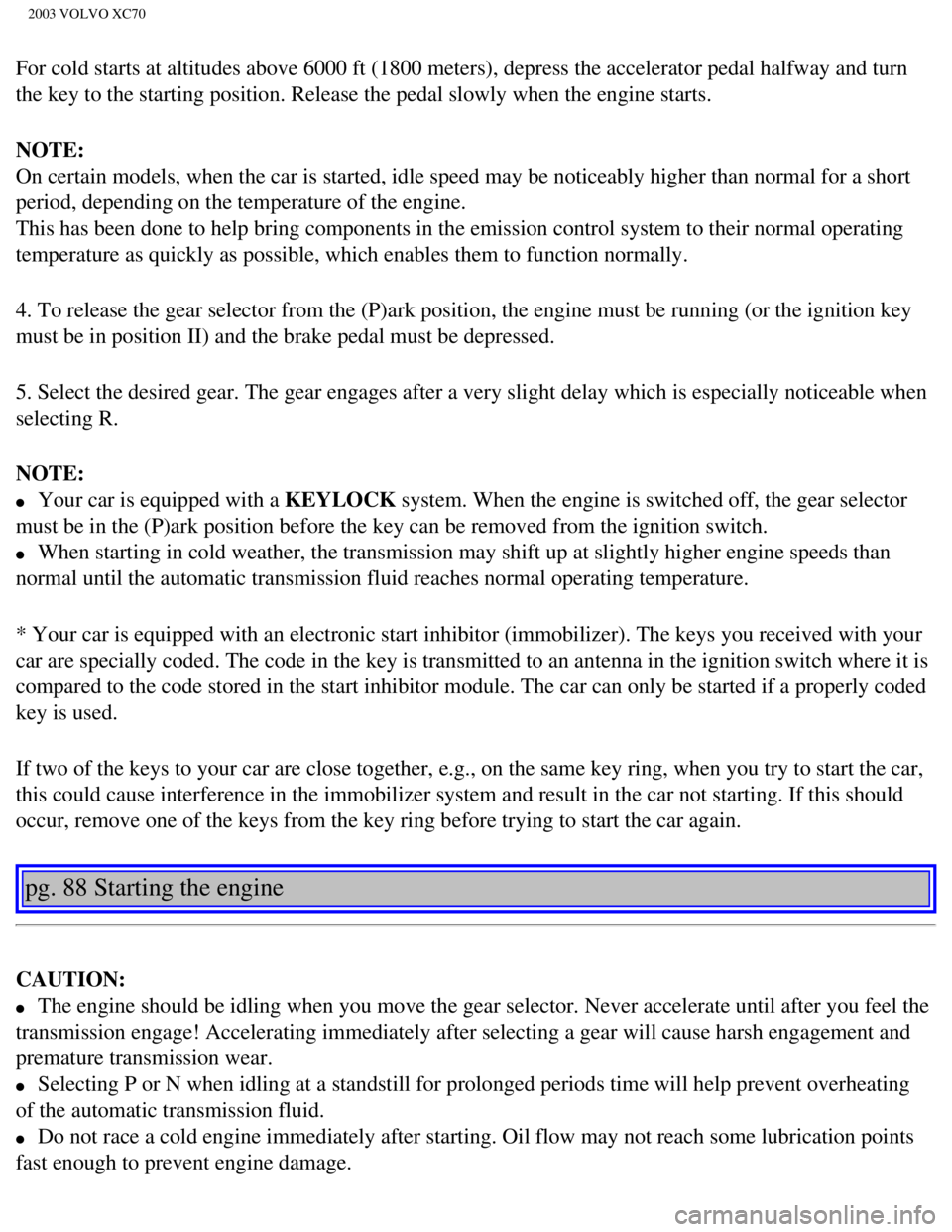
2003 VOLVO XC70
For cold starts at altitudes above 6000 ft (1800 meters), depress the \
accelerator pedal halfway and turn
the key to the starting position. Release the pedal slowly when the engi\
ne starts.
NOTE:
On certain models, when the car is started, idle speed may be noticeably\
higher than normal for a short
period, depending on the temperature of the engine.
This has been done to help bring components in the emission control syst\
em to their normal operating
temperature as quickly as possible, which enables them to function norma\
lly.
4. To release the gear selector from the (P)ark position, the engine m\
ust be running (or the ignition key
must be in position II) and the brake pedal must be depressed.
5. Select the desired gear. The gear engages after a very slight delay w\
hich is especially noticeable when
selecting R.
NOTE:
l Your car is equipped with a KEYLOCK system. When the engine is switched off, the gear selector
must be in the (P)ark position before the key can be removed from the \
ignition switch.
l When starting in cold weather, the transmission may shift up at slightly\
higher engine speeds than
normal until the automatic transmission fluid reaches normal operating t\
emperature.
* Your car is equipped with an electronic start inhibitor (immobilizer)\
. The keys you received with your
car are specially coded. The code in the key is transmitted to an antenn\
a in the ignition switch where it is
compared to the code stored in the start inhibitor module. The car can o\
nly be started if a properly coded
key is used.
If two of the keys to your car are close together, e.g., on the same key\
ring, when you try to start the car,
this could cause interference in the immobilizer system and result in th\
e car not starting. If this should
occur, remove one of the keys from the key ring before trying to start t\
he car again.
pg. 88 Starting the engine
CAUTION:
l The engine should be idling when you move the gear selector. Never accel\
erate until after you feel the
transmission engage! Accelerating immediately after selecting a gear wil\
l cause harsh engagement and
premature transmission wear.
l Selecting P or N when idling at a standstill for prolonged periods time \
will help prevent overheating
of the automatic transmission fluid.
l Do not race a cold engine immediately after starting. Oil flow may not r\
each some lubrication points
fast enough to prevent engine damage.
file:///K|/ownersdocs/2003/2003_XC70/03xc70_06a.htm (6 of 22)12/30/200\
6 4:17:59 PM
Page 140 of 257

2003 VOLVO XC70
lower with the air conditioning on and the windows closed than with the \
air conditioning off and the
windows open.
l Using the onboard trip computer's fuel consumption modes can help you le\
arn how to drive more
economically.
Other factors that decrease gas mileage are:
l Dirty air cleaner
l Dirty engine oil and clogged oil filter
l Dragging brakes
l Incorrect front end alignment Some of the above mentioned items and othe\
rs are checked at the
standard Maintenance Service intervals.
NOTE: Vehicles equipped with automatic transmissions should use (D)rive as o\
ften as possible and
avoid using "kick-down" to help improve fuel economy. Vehicles equipped \
with manual transmissions
should use fifth gear at highway speeds. At other times, choose the high\
est gear that still allows smooth
acceleration.
Weight distribution affects handling
At the specified curb weight your car has a tendency to understeer, whic\
h means that the steering wheel
has to be turned more than might seem appropriate for the curvature of a\
bend. This ensures good
stability and reduces the risk of rear wheel skid. Remember that these p\
roperties can alter with the
vehicle load. The heavier the load on the rear of the vehicle (e.g., he\
avily loaded (max. 220 lbs, 100 kg)
cargo area or when towing a trailer, the less the tendency to understeer\
.
Handling, roadholding
Vehicle load, tire design and inflation pressure all affect vehicle hand\
ling. Therefore, check that the tires
are inflated to the recommended pressure according to the vehicle load. \
See "Tire pressure" section.
Loads should be distributed so that capacity weight or maximum permissib\
le axle loads are not
exceeded.
pg. 96 Points to remember
Cooling system
The risk for engine overheating is greatest, especially in hot weather, \
when:
l Towing a trailer up steep inclines for prolonged periods at wide open th\
rottle and low engine rpm.
l Stopping the engine suddenly after high speed driving (so-called "after\
-boiling" can occur).
l To avoid overheating, the following rules should be followed: Do not dri\
ve for prolonged periods at
file:///K|/ownersdocs/2003/2003_XC70/03xc70_06a.htm (17 of 22)12/30/20\
06 4:18:00 PM